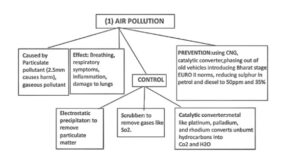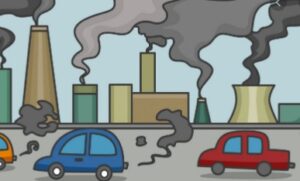Phase 2: Investigate: Inquiry Project Brainstorm
The aim is to create a lesson plan for the class 7 students on the topic of air pollution. By keeping this purpose in mind, key questions, broad stroke plans, learning principles of the British Columbia curriculum have been explained. The understanding of inquiry-based pedagogy has been described.
Key Highlights
The selected approach for teaching students on this topic would be inquiry-based class resources, teaching strategies, assessments on the selected topic of air pollution to make the students understand and develop concepts about air pollution and its negative impact on human life and the planet.
Key Questions
Q1: What is air pollution?
Q2: What are the causes of air pollution?
Q3: What are the impacts of air pollution?
Q4: How to reduce the negative impact of air pollution?
Q5: Whom does air pollution affect the most?
By considering these above-mentioned questions, students will be able to understand the various aspects of air pollution and its impact on human life and on the planet as a whole. Students will be able to know the process of protecting the planet from the adverse impact of air pollution. This concerned phase will help the students to explore the various unknown areas related to air pollution. This lesson will enable the students to become responsible citizens in near future in order to prevent air pollution.
Broad stroke plans
Plan
In this section, a detailed plan for teaching the standard 7 students about air pollution has been discussed. As a part of teaching and learning resources the flow chart, diagram, short movies on air pollution, question-answer session, colorful pictures, clip arts and graphics on air pollution, word search on air pollution, etc. These teaching and learning resources have been identified by considering the ability and capacity of the class 7 students. Before starting the class on air pollution the teacher might ask questions to the students about their idea on air pollution. Once it is understood by the teacher the learning resources could be used according to the plan. The flow chart will show how air pollution has been started and the end line of the flow chart will show the current situation of this planet due to air pollution. The diagram will discuss the various reasons for air pollution. Multiple numbers of flow charts and diagrams could be used based on the need of the teaching session. The animated short video clips could be shown to the students on air pollution and its negative impact on this planet. Through question-answer sessions and assessment, the teacher will be able to understand students’ learning ability in the context of air pollution. Colorful content with clip arts could be shown to the students as a part of their learning. It would be easier for the students to learn and memorize the lesson if they are taught in a practical way rather than entirely theory-based learning. The plan has well included into the standards, relevant principles of the Standard 7 British Curriculum. An alignment has been made with the principle aspects of the science topic of the said standard with the relatable big idea and learning principles. As per the viewpoint of Friesen, (2009), if schools are to continue to exist in a knowledge society, they have to change. Therefore these changes do not consider adding or improving the existing ones but include new learning formats such as the inquiry-based pedagogy to upgrade and facilitate the new forms of learning.
Resources
Flow Chart

Figure 1: Air Pollution Flow Chart
Clip art

Figure 2: Air Pollution clip art
Short Video on Air Pollution
https://www.youtube.com/watch?v=t7Q7y_xjR5E
https://www.youtube.com/watch?v=Mpcil0H5Pos
Possibilities and concern
The above plan will certainly develop ideas amongst the students about air pollution and its relevant aspects. The possible areas are students will develop their learning and concept about air pollution, their area of knowledge will expand. In the near future, they will become a responsible citizen who will try to protect the environment and its natural resources. The students will think about the well-being of the planet and its resources. As a part of the concern, it could be stated that it might happen that students might not be able to develop detailed ideas about air pollution. The students might not be able to express their areas of concern in regards to their teaching process.
Relevant learning principles
K-12 core competencies
Under the core competency of evaluating the students of class 7 in regards to the topic of air pollution will be to demonstrate an understanding and appreciation of evidence in regards to such kind of environmental issue (www.curriculum.gov.bc.ca, 2020).
Big Ideas
Based on this principle of the BC curriculum the big ideas that follow this particular topic are majorly in consequence of the climatic changes of the Earth. Air pollution has been turned out to be the product of the changes in the climate of the earth over geological time (www.curriculum.gov.bc.ca, 2020).
Learning Standards for Curricular Content
Based on the above plan, in this phase, the specific principle of the BC curriculum that has been included is personal and social competency. It is important for the teachers to know about the social and personal competency level of the students. The plan has considered this section because this would enable the teacher to develop learning materials based on the cognitive development of the class 7 students.
First people principles for learning
In this context the principle that has been kept in mind by the teachers to teach students about air pollution is illustrations. Burden, Kearney, Schuck & Burke (2019) opined that The First Peoples Principles of Learning is the learning philosophy underpinning British Columbia’s (BC) recently redesigned curriculum. Student-teacher reflection, student work sample, observation of the teacher, etc. The plan has considered all these principles because this would certainly increase students’ learning abilities. Understanding human learning is a vital and pressing issue worldwide, but learning is not restricted to humans (Dyer, Garcia, Howard, Weber & Greentree, 2019).
Current understanding of inquiry-based pedagogy
Inquiry-based pedagogy is a set of strategies in the field of learning and teaching students. These strategies are helpful enough for the teachers to understand the learning capability of the students and their power of adopting lessons with the help of learning resources. By applying these strategies the teachers are able to prepare the students and their thinking power according to their biological age. Inquiry-based pedagogy is indeed helpful for the students to be engaged in the process of learning and teaching. Fitzgerald, Danaia & McKinnon (2019) stated that calls for the professional development of teachers to increase the implementation of inquiry-based learning have been common over the last few decades. The significant application of the inquiry-based pedagogy would help students to have an understanding of the application of skills like evaluation, assessments, and critical thinking which is determined to be the ultimate foundational base of the inquiry. In addition to this, the particular pedagogy helps in providing a platform where they could intricate into curiosity along with an assessment of the actions they conduct. In the opinion of(Jardine & Kraemer, (2005) the inclusion of nature if the inquiry does not necessarily mean that the one that experiences have all the knowledge instead it helps them to use that experienced knowledge inexperienced new frames that are yet to come.
In order to make the students of standard 7 about air pollution, a teaching-learning plan has been prepared by considering the BC curriculum and its different principles. This has discussed the varieties of learning resources that could be used to teach students on the selected topic.